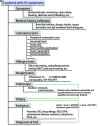Eosinophilic gastroenteritis: Pathogenesis, diagnosis, and treatment
- PMID: 37022943
- PMCID: PMC10278761
- DOI: 10.1097/CM9.0000000000002511
Eosinophilic gastroenteritis: Pathogenesis, diagnosis, and treatment
Abstract
Eosinophilic gastroenteritis (EGE) is a gastrointestinal disorder of unclear etiology that is characterized by eosinophilic infiltration of the stomach and small intestine, and consists of mucosal, muscular, and serosal subtypes. Eosinophilic infiltration of the gastrointestinal tract is a fundamental histopathological characteristic of EGE and is driven by several T-helper type 2 (Th2)-dependent cytokines and induced by food allergy. Due to the lack of a diagnostic gold standard, EGE has a high rate of delayed diagnosis or misdiagnosis. However, several new diagnostic strategies have been developed, such as novel genetic biomarkers and imaging tests. Although dietary therapy and corticosteroids remain the common choices for EGE treatment, recent decades have seen the emergence of novel treatment alternatives, such as biologics that target particular molecules involved in the pathogenic process. Preliminary investigations and clinical trials have demonstrated the efficacy of biologics and provided additional insights for the era of refractory or corticosteroid-dependent EGE biologics.
Copyright © 2023 The Chinese Medical Association, produced by Wolters Kluwer, Inc. under the CC-BY-NC-ND license.
Conflict of interest statement
None
Figures


Similar articles
-
Diagnosis of eosinophilic gastroenteritis is easily missed.World J Gastroenterol. 2017 May 21;23(19):3556-3564. doi: 10.3748/wjg.v23.i19.3556. World J Gastroenterol. 2017. PMID: 28596692 Free PMC article.
-
Eosinophilic Gastroenteritis: Clinical Manifestation, Natural Course, and Evaluation of Treatment with Corticosteroids and Vedolizumab.Dig Dis Sci. 2019 Aug;64(8):2231-2241. doi: 10.1007/s10620-019-05617-3. Epub 2019 Apr 13. Dig Dis Sci. 2019. PMID: 30982212
-
Eosinophilic gastroenteritis: Clinical characteristics and management.Indian J Gastroenterol. 2021 Jun;40(3):338-343. doi: 10.1007/s12664-021-01160-0. Epub 2021 May 28. Indian J Gastroenterol. 2021. PMID: 34047958
-
Eosinophilic Gastroenteritis : Brief Review.Acta Gastroenterol Belg. 2016 Apr-Jun;79(2):239-44. Acta Gastroenterol Belg. 2016. PMID: 27382945 Review.
-
Diagnosis, Natural History and Treatment of Eosinophilic Enteritis: a Review.Curr Gastroenterol Rep. 2018 Jul 2;20(8):37. doi: 10.1007/s11894-018-0645-6. Curr Gastroenterol Rep. 2018. PMID: 29968127 Review.
Cited by
-
Long-term prognosis and its associated predictive factors in patients with eosinophilic gastroenteritis.World J Gastroenterol. 2024 Jan 14;30(2):146-157. doi: 10.3748/wjg.v30.i2.146. World J Gastroenterol. 2024. PMID: 38312116 Free PMC article.
-
Eosinophilic Enteritis Causing Recurrent Small Bowel Obstruction: A Case Report.Cureus. 2024 Feb 17;16(2):e54355. doi: 10.7759/cureus.54355. eCollection 2024 Feb. Cureus. 2024. PMID: 38500945 Free PMC article.
-
Eosinophilic gastroenteritis without identifiable allergens in an adult: A case report.SAGE Open Med Case Rep. 2025 Feb 3;13:2050313X241312935. doi: 10.1177/2050313X241312935. eCollection 2025. SAGE Open Med Case Rep. 2025. PMID: 39906476 Free PMC article.
-
A Nationwide Retrospective Analysis of Socioeconomic Factors Associated With Eosinophilic Colitis: A Population-Based Study.Gastro Hep Adv. 2025 Mar 22;4(7):100663. doi: 10.1016/j.gastha.2025.100663. eCollection 2025. Gastro Hep Adv. 2025. PMID: 40491439 Free PMC article.
-
Eosinophilic gastroenteritis with negative endoscopic biopsy and no peripheral eosinophilia: A case report.Medicine (Baltimore). 2025 Jul 18;104(29):e43289. doi: 10.1097/MD.0000000000043289. Medicine (Baltimore). 2025. PMID: 40696579 Free PMC article.
References
-
- Rothenberg ME Hottinger SKB Gonsalves N Furuta GT Collins MH Talley NJ, et al. . Impressions and aspirations from the FDA GREAT VI workshop on eosinophilic gastrointestinal disorders beyond eosinophilic esophagitis and perspectives for progress in the field. J Allergy Clin Immunol 2022;149: 844–853. doi: 10.1016/j.jaci.2021.12.768. - PMC - PubMed
-
- Klein NC, Hargrove RL, Sleisenger MH, Jeffries GH. Eosinophilic gastroenteritis. Medicine (Baltimore) 1970;49: 299–319. doi: 10.1097/00005792-197007000-00003. - PubMed
-
- Mansoor E, Saleh MA, Cooper GS. Prevalence of eosinophilic gastroenteritis and colitis in a population-based study, from 2012 to 2017. Clin Gastroenterol Hepatol 2017;15: 1733–1741. doi: 10.1016/j.cgh.2017.05.050. - PubMed
MeSH terms
Substances
Supplementary concepts
LinkOut - more resources
Full Text Sources
Medical

